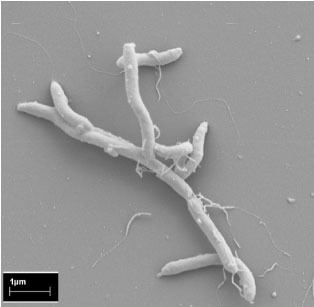Thermoanaerobacter is a genus in the phylum Firmicutes (Bacteria). Members of this genus are thermophilic and anaerobic, several of them were previously described as Clostridium species and members of the now obsolete genera Acetogenium and Thermobacteroides
The name Thermoanaerobacter derives from:
Greek adjective thermos (θερμός), hot; Greek prefix an (ἄν), not; Greek noun aer, aeros (ἀήρ, ἀέρος), air; New Latin masculine gender noun, a rodbacter, nominally meaning "a rod", but in effect meaning a bacterium, rod; New Latin masculine gender noun Thermoanaerobacter, rod which grows in the absence of air at elevated temperatures.
The genus contains 15 species, namely
T. acetoethylicus ( (Ben-Bassat and Zeikus 1983) Rainey and Stackebrandt 1993, ; Latin noun acetum, vinegar; New Latin adjective ethylicus, pertaining to ethyl alcohol; New Latin masculine gender adjective acetoethylicus, intended to mean producing acetic acid and ethanol.) This species, formerly known as Thermobacteroides acetoethylicus, used to be the type species of Thermobacteroides, but was transferred over to the genus Thermoanaerobacter, while the other member of the genus Thermobacteroides, Thermobacteroides proteolyticus was reclassified as Coprothermobacter proteolyticusT. brockii ( (Zeikus et al. 1983) Lee et al. 1993, ; New Latin genitive case noun brockii, of Brock, named for Thomas Dale Brock who pioneered studies on the physiology and ecology of thermophiles.) this species was previously known as Thermoanaerobium brockiiT. ethanolicus ( Wiegel and Ljungdahl 1982, (Type species of the genus).; New Latin noun ethanol, ethanol; Latin masculine gender suff. -icus, suffix used with the sense of pertaining to; New Latin masculine gender adjective ethanolicus, indicating the production of ethanol.)T. italicus ( Kozianowski et al. 1998, ; Latin masculine gender adjective italicus, pertaining to Italy, where the organism was isolated.)T. kivui ( (Leigh and Wolfe 1983) Collins et al. 1994, ; New Latin genitive case noun kivui, pertaining to Kivu, named for its source, Lake Kivu.) This species used to be known as Acetogenium kivui (sole member of the genus) before being transferredT. mathranii ( Larsen et al. 1998, ;: New Latin genitive case noun mathranii, of Mathrani, in honor of the late Indra M. Mathrani, who contributed to the understanding of thermophilic anaerobes from hot springs during his short career.)T. pseudethanolicus ( Onyenwoke et al. 2007, ; Greek adjective pseudēs, false; New Latin adjective ethanolicus, a bacteria-specific epithet; New Latin masculine gender adjective pseudethanolicus, a false (Thermoanaerobacter) ethanolicus.)T. siderophilus ( Slobodkin et al. 1999, ; Greek noun sideros, iron; New Latin adjective philus from Greek adjective philos (φίλος) meaning friend, loving; New Latin masculine gender adjective siderophilus, iron-loving.)T. sulfurigignens ( Lee et al. 2007, ; Latin noun sulfur, sulfur; Latin participle adjective gignens, producing; New Latin participle adjective sulfurigignens, sulfur-producing.)T. sulfurophilus ( Bonch-Osmolovskaya 1998, ; Latin noun sulfur, sulfur; New Latin adjective philus from Greek adjective philos (φίλος) meaning friend, loving; New Latin masculine gender adjective sulfurophilus, liking elemental sulfur.)T. thermocopriae ( (Jin et al. 1988) Collins et al. 1994, ; Greek noun thermē (θέρμη), heat; Greek noun kopria, dunghill; New Latin genitive case noun thermocopriae, of heat compost.) This species was formerly known as Clostridium thermocopriaeT. thermohydrosulfuricus ( (Klaushofer and Parkkinen 1965) Lee et al. 1993, ; Greek adjective thermos (θερμός), hot; New Latin masculine gender adjective hydrosulfuricus, pertaining to hydrogen sulfide; New Latin masculine gender adjective thermohydrosulfuricus, indicating that the organism grows at high temperatures and reduces sulfite to H2S.), this species also used to be Clostridium thermohydrosulfuricumThermoanaerobacterium thermosaccharolyticum, Collins et al. 1994T. uzonensis ( Wagner et al. 2008, ; New Latin masculine gender adjective uzonensis, pertaining to the Uzon Caldera, Kamchatka, Far East Russia.)T. wiegelii ( Cook et al. 1996, ; New Latin genitive case noun wiegelii, of Juergen Wiegel, in recognition of his contributions to the study of thermophilic anaerobes.)Three members of this genus, T. subterraneus, T. tengcongensis and T. yonseiensis, were reclassified as subspecies of Caldanaerobacter subterraneus

